Developments in Heat Transfer Part 14 pot
Bạn đang xem bản rút gọn của tài liệu. Xem và tải ngay bản đầy đủ của tài liệu tại đây (3.61 MB, 40 trang )
Developments in Heat Transfer
510
8143
lg( 133.3) 8.0
l
P
T
=− (7)
When the temperature is between 700~1400 K, equation (7) coincides with equation (6).
2.5 The compatibility
Eliminating the fabrication factors, the compatibility of high and super high temperature
heat pipes are due to the micro cell erosions, the shell and wick materials dissolve in the
working fluids. In addition, the micro cell erosion can make the inner surface be granulating
erosion and make the shell wall thinner. The temperature level will influence the
compatibility essentially. Busse found that for tungsten and rhenium alloy-lithium heat
pipe, the heat pipe longevity is several years, one year and one month respectively,
corresponding to the temperatures 1600°C, 1700°C and 1800°C (Busse 1992). The effects of
temperature level to the longevity are very obvious.
Table 5 shows the general results of compatibility, this is the basic principle to select the
couple of shell material and alkali metal.
SS Ni Ni alloy W Ta Mo Re Ti Nb
Lithium × × × √ √ √ √ × √
Sodium √ √ √ — — — — × √
√: compatibility tested; ×: non-compatibility tested
Table 5. General results of compatibility
Fig. 5. Positions on element periodic table of materials suitable for super high temperature
heat pipes
Considering all the important factors, the high temperature material, the above mentioned
mciro cell erosion, high temperature alloy properties, the compatibility with the alkali
metals, and the experimental results, figure 5 gives the selected heat pipe materials, signed
as “ellipse” in the chemistry element periodic table. From 4B~7B rows, tungsten, tantalum,
molybdenum, rhenium and niobium are good candidates to the high and super high
temperature heat pipes.
In the mean time, the material selection should consider the material machining properties
and availability, the price and other factors.
Progress Works of High and Super High Temperature Heat Pipes
511
3. Startup analysis of alkali metal heat pipe
For alkali metal heat pipes, commonly, the working fluid in heat pipes is solid state. The
heat transfer into the evaporator make the solid working fluid melt, then one equivalent
heating section is formed. If the heat pipe is started up by heating one end, such as the heat
pipe has only one end heating section for the high mach stagnant point. As shown in figure
6, when the solid working fluid is melted completely the temperature distribution along the
heat pipe is given.
x, mm 200
x
0
0
Δ
t
1
Δ
t
2
T
(°C)
T
end
97.72
25.00
Fig. 6. Temperature distribution along the heat pipe when the solid working fluid is melted
completely
For one concrete high temperature heat pipe, the cross-section area is 0.7536cm
2
. At 700°C,
the thermal conductivity of heat pipe shell material is 25W/(m.°C). If the startup power is
50W, the axial temperature difference will reach 26°C/mm by Fourier law. Obviously, there
will be bigger temperature difference along the axial direction. When the heat pipe is started
up, if the melted working fluid is not enough to make all the solid working fluid melt
wholly, then the startup will fail. In order to control the highest temperature of the stagnant
point, the heat applied should be lower than one level.
3.1 Analysis of startup time
For the horizontal sodium heat pipe, the ambience temperature is 25°C, then the sodium is
solid before startup. Between the temperature range 25~97°C, the thermal conductivity and
the heat capacity of sodium are considered as constants. And from 25°C to 800°C, the heat
pipe shell is taken as constant. The axial conduction of the wick is ignored.
The sodium should be heated to melt completely, from room temperature 25°C to the
melting point 97.72°C. The solid working fluid inside heat pipe is assumed to distribute
uniformly. The thermal capacity of the heat pipe is C
tube
=53J/K, the thermal capacity of the
working fluid is C
Na
=3.14 J/K. For the sodium, the melting latent heat is L
melt
=113kJ/kg, the
latent heat of evaporation is h
fg
=4215kJ/kg. The heat to evaporate the working fluid should
be large than that, the heat to increase the temperature to the melting point and the heat to
melt the solid working fluid completely in the condenser, there is,
()
11
1
200 200
fg
tube Na melt
xx
Whm C C TmL
⎛⎞
⎡
⎤
==− +Δ+
⎜⎟
⎣
⎦
⎝⎠
(8)
Developments in Heat Transfer
512
When the solid working fluid melt wholly, the temperature distribution is given in figure 4.
∆T
1
is the temperature difference between the melting point to the room temperature. x
0
is
the needed length to evaporate the working fluid. For the given sodium heat pipe A without
groove, x
0
= 58.6mm; while for the heat pipe B with groove, x
0
= 33.24mm by equation (8).
It is assumed that there is no heat transfer between the heat pipe condenser and the
ambience. Then the startup heat transfer is estimated as,
()
2
21
200 2
tube Na melt tube
xT
WC C TmL C
Δ
=+Δ+ +
(9)
∆T
2
/2 is the mean temperature difference between the evaporator temperature and the
sodium melting point.
For the evaporator, there is only the axial conduction along the heat pipe shell. The heat
transfer rate is given by Fourier law as
Q AdT dx
λ
=− (10)
Considering equations (8) and (10), the relation between the input power and the end
temperature can be obtained. The startup time is given also by equation (8) and (10) as,
2
tWQ=
(11)
3.2 Results of startup time
From the data of the sodium melting heat with pressure and temperature, it is known that
the melting point changes little with the pressure. The melting point and melting heat are
taken for one standard atmosphere pressure to calculate the startup time. The startup power
should be controlled not to exceed one value, which can make the evaporator dryout before
all the solid working fluid is melted completely.
100 200 300 400 500 600 700 800 900 1000
0
5
10
15
20
25
30
388s
406s
430s
461s
505s
570s
679s
894s
1528s
Q(W)
T(
o
C)
0 200 400 600 800 1000 1200
0
5
10
15
20
25
30
35
40
45
176s
189s
204s
225s
255s
299s
372s
516s
942s
Q(W)
T(
o
C)
(a) (b)
Fig. 7. Relations of heat transfer rate, startup time and temperature. (a) with screen wick,
without groove (b) with screen wick and with grooves
For the sodium heat pipe A and B, the results are shown in figure 7. At the same startup
heat transfer rate, 20W, the startup time of A and B is 450S and 290S respectively.
Progress Works of High and Super High Temperature Heat Pipes
513
4. Technology control of alkali metal heat pipe
The performance of heat pipe depends on the fabrication technology. The charging process
should guarantee the vacuum level before filling. The working fluid quantity charged
should be controlled. The working fluid has enough purity, the oxidization and impurities
are at the endurable levels, the seal is soldered and guaranteed etc
4.1 The vacuum level control
Commonly, if the pressure is less one atmosphere, 1.01×10
5
Pa , the vacuum is divided by
several regions, as shown in table 6 (Zhang et al,1987).
Region
Pressure
(Pa)
Density of
molecule number,
n(cm
-3
)
Mean free
journey,
λ(cm)
Little vacuum 1.01×10
5
~10
3
~10
18
10
-4
Low vacuum 10
3
~10
-1
~10
15
10
-1
High vacuum (HV) 10
-1
~10
-6
~10
10
10
3
Super high vacuum (UHV) 10
-6
~10
-12
~10
6
10
9
Extreme high vacuum (XHV) <10
-12
<10
2
>10
12
Table 6. The vacuum region partitions
For the high and super high temperature heat pipes, the vacuum region had better reach the
levels of HV, if the vacuum is UHV or XHV, the technology will last long and the cost is
increased a lot. If the vacuum is little or low, then the heat pipes have worse performances
as shown in figure 8.
Fig. 8. The heat pipes have worse performances if the vacuums was low
4.2 The distillation technology
The distillation technology can make the alkali metal melt and evaporate. By controlling the
temperature of distillation, the alkali metal is purified a lot, then the liquid alkali metal is
charged into the candidate heat pipe. Such method keeps the system to be active vacuum,
the vacuum equipment works continuously. This can keep the alkali metal purity, not to be
oxidized by a little leakage air.
Developments in Heat Transfer
514
Probe of liquid
surface
Argon
Sodium tank
Va
l
ve
Distillation
tank
U tube
Cooling water
Argon
Vacuum
equipment
Condensation
tube
Cooling trap
Connection
Vent pipe
Heat pipe
Fig. 9. Distillation technology of high temperature heat pipe
As shown in figure 9, the charging system consists of sodium tank, U tube, distillation tank,
connection, cooling trap and vacuum equipment. The argon can protect the alkali metal in
the sodium tank. The charging process includes two steps. Firstly, the set amount of alkali
metal is filled from the sodium tank to the distillation tank. Secondly, the alkali metal is
distilled and charged into the heat pipe.
For sodium, after pumping the system and the vacuum is permitted, the distillation tank is
heated to a certain temperature, in the mean time the other part of the system has different
temperature, such as, the outlet of the condensation tube should be controlled between
150~200°C. The much higher temperature can make sodium vapor be pumped into the
vacuum equipment. The much lower temperature will lead to the higher viscosity of liquid
sodium, then the small vent pipe can be jammed. Based on the same reasons, the connections,
heat pipe, especially for the vent pipe also should be heated to about 200°C. After the other
parts of the system reach the set temperature, the distillation tank is heated to a temperature
between 480~500°C, and this temperature is kept constant to distill the sodium. The
temperatures at every part are monitored. If the sodium is vaporized totally, the temperature
of distillation tank will increase a lot, then stop heating the distillation tank.
Obviously, the distillation technology is complicated a little, and the consumptions of time,
water and power are large. Once, only one heat pipe can be charged. And the after-
treatment is also complicated, the sodium remains in the tubes are hard to be cleaned up.
4.3 The non-distillation technology
In order to make the charging process simple and several or many heat pipes can be filled
simultaneously, the three-path-equipment of alkali metal charging was invented. As shown
in figure 10.
The non-distillation charging system is composed of the vacuum equipment, the transparent
glove chamber with argon protection, the valves of super high vacuum and tubes. There are
three paths, can realize three alkali metal heat pipes charging simultaneously. For example,
the flange of the first path is disconnected, the empty lower tank is put downward into the
transparent glove chamber with argon protection. Also, the heat pipe end is inserted into
one small tube, by which the air is replaced by argon. In this glove chamber, the alkali metal
is cut, weighed and put into the tank, which outlet is set stainless steel screen. Then the tank
with alkali metal is lifted to couple the flange and the system is closed by bolts and valves.
Progress Works of High and Super High Temperature Heat Pipes
515
During this process, the main tube of the system is also blowed by argon. The system is
pumped some time, and the argon in the system is evacuated as much as possible.
Here it is pointed out that the argon in the heat pipe is pumped out through the tank of alkali
metal, the argon will cross the alkali metal by the aperture passage. By the bypass designed
near the outlet of the alkali metal tank, the vacuum of heat pipe can be increased a lot.
Transparent glove
chamber with
argon protection
Big valve of
super high
Vacuum
Vacuum
e
q
ui
p
ment
Small valve o
f
super high
Vacuum
Heat
p
i
p
e
Jack
Tank of
alkali metal
Fig. 10. Non-distillation technology of alkali metal heat pipe
Fig. 11. Three-path-equipment of alkali metal charging (figure 10)
After that, the alkali metal tank, the lower connection and the heat pipe is heated by the
outside heaters. The temperature can reach 150~160°C or so for sodium. If the alkali metal
inside is melted completely, then the big valve of high vacuum is closed, the pump
equipment is cut off. The small valve of high vacuum is opened and the argon will push the
alkali metal into the heat pipe. Then the small valve is closed and the big valve is opened.
The system is evacuated again to a high vacuum level. Finally, the heat pipe is sealed by a
special plier, soldered by a welder. A heat pipe is charged successfully.
Figure 11 is the photo of three-path-equipment.
Developments in Heat Transfer
516
4.4 The technology monitoring
The monitor equipment of technology is shown in figure 12. The power increase can be set
to heaters. The thermal couples and resistances are connected to the equipment. The computer
and the inserted instruments are two-level system. The computer, digital instruments,
controllable silicon, switches, contactors, buttons etc., are installed into the instrumental
cabinet. By the computer, the technology process can be realized.
Fig. 12. Monitor equipment of heat pipe technology
The instruments and the sensors are connected to collect data and control the process. By the
RS485 communication bus, the computer can display the process on time, the interface is
displayed by Chinese. The data can be storaged in the computer.
The performance of heat pipe depends on the process technology essentially.
5. Experimental results of alkali metal heat pipes
5.1 Startup from ambience
The startup experiments can test the heat pipe performance before the heat pipe is applied.
As shown in figure 11(a), the evaporator is heated by high frequency heater, the heat pipe is
set inside the high frequency loops, and the thermocouples are set along the condenser,
which is in the ambient air. By the high frequency heater, the heat flux can be very large,
and the some dryout point may be displayed by thermocouples.
(a) (b) (c)
Fig. 13. Test rig of alkali metal heat pipe and startup photos of sodium heat pipes. (a) Test
rig of heat pipe (b) Startup experiment, 5° anti-gravity (c) Startup, horizontal
The experimental photos are shown in figure 13 (b) and (c). By the color of the condenser,
the sodium heat pipe can be started up successfully. The color is uniform along the
condenser, the isothermal performance of the heat pipes are good. The purity of working
Progress Works of High and Super High Temperature Heat Pipes
517
fluid and the high vacuum technology can guarantee that there is no noncondensible gas in
the fabricated heat pipes.
As in figure 14, temperatures of three condenser points are demonstrated for horizontal
position. For about 100S, the heat pipe can be started up. For 10 degree tilt angle, the
evaporator is set lower, the results of sodium heat pipe startup is shown in figure 15. For
another power step, the heat pipe performance is also satisfied.
0 50 100 150 200 250 300
100
200
300
400
500
600
700
T(℃ )
t (s)
T
1
T
2
T
3
Fig. 14. Startup of horizontal sodium heat pipe
0 100 200 300 400 500
0
100
200
300
400
500
600
700
T
( ℃ )
t
(s)
T
1
T
2
T
3
Fig. 15. Startup and power increased test of 10° degree tilt angle
5.2 Experiments in wind tunnel of electricity arc
By the high and super high temperature heat pipes, the local higher heat flux is moved to
the lower heat flux region, the heat is moved from the “peak point” to the “valley region” by
heat pipe, then the highest temperature is decreased a lot.
In a wind tunnel of electricity arc, three heat transfer elements as CC material, high
conduction CC material and heat pipes are tested and compared, as shown in figure 16.
Developments in Heat Transfer
518
From figure 16, after 1200s, the heat pipe is started up successfully. The operation lasts
nearly 5 minutes.
The upper three curves are the temperature histories of the stagnant points. The
temperature of heat pipe stagnant point is lower than the other CC and high conduction CC
elements, 120°Cand 50°C lower respectively. The heat pipe behaves good performance.
Fig. 16. Experimental temperatures of different method by arc tunnel heating (By China
Academy 11)
6. Limits of alkali metal heat pipes
6.1 Continuum flow limit
With the decreasing of dynamic diameter, the heat pipe vapor flow may transit from the
continuum flow to the free molecule flow. The continuum limit can be judged by the
Knudsen number as,
Kn
D
λ
=
(12)
Here,
λ is the free length of molecules, D is the minimum size of the vapor flow in heat pipe.
If
Kn≤0.01, the flow is continuum; if Kn>0.01, the flow belongs to the free molecules. For the
latter situation, the heat pipe may lose its performance.
Cao and Fahgri derived the transition temperature as (Faghri, 1992),
0
0
11
exp
fg
tr
tr g g tr
h
P
T
RRTT
ρ
⎡
⎤
⎛⎞
=−−
⎢
⎥
⎜⎟
⎢
⎥
⎝⎠
⎣
⎦
(13)
Substitute Kn=0.01 into equation (13), the transition temperature can be obtained.
As shown in figure 17, for sodium heat pipe, change of transition temperature with the
dynamic diameter is given. If the dynamic diameter is decreased less than 1mm, the
heat pipe
stagnant point
CC stagnant point
High conduction CC
stagnant point
Progress Works of High and Super High Temperature Heat Pipes
519
continuum limit occurs. The transition temperature will increase with decreasing the
diameter. When the dynamic diameter is 50
μm, the transition temperature will be 830°C.
This temperature is in the range of normal temperature 500~1100°C. Such results mean that
the heat pipe will work at much higher temperature than the designed, in the mean time,
the heat transfer rate decreases.
0.000 0.001 0.002 0.003 0.004 0.005
500
600
700
800
900
Working fluid: Sod ium
T
tr
,
o
C
d , m
Fig. 17. For sodium heat pipes, change of transition temperature with the dynamic diameter
6.2 Other possible limits
When the alkali metal heat pipes are started up from low temperature, the vapor density is
very small. The viscous resistance may dominate (Ma et al, 1983). At the end of the
condenser, the vapor pressure decreases to extreme low, nearly zero. Then the viscous limit
is reached as,
2
,,
64
v
vis v o v o
veff
DL
QP
l
ρ
μ
=
(14)
If the alkali metal heat pipes operate at low vapor pressure, the vapor density is small and
the velocity is big, then the sonic velocity may choke the heat transfer, the sonic limit is
expressed as,
,,
0.474
s v vo vo
QLAP
ρ
= (15)
When the vapor flow can entrain the liquid, the inertial force is bigger enough, the
entrainment limit is given as,
2
2
Ev v
QA L
π
σρ λ
= (16)
The capillary limit can be calculated by,
2
lw
cap
lee
ff
LKA
Q
rl
σρ
μ
⎛⎞
⎛⎞
⎜⎟
=
⎜⎟
⎜⎟
⎝⎠
⎝⎠
(17)
Developments in Heat Transfer
520
The basic heat transfer limits are given in figure 18 for sodium heat pipe. If the temperature
is lower than 500°C, the sonic limit should be paid attention. When the temperature is
between 500°C and 900°C, the entrainment limit is easy to occur, the temperature 700°C
corresponds to 756W, then the heat flux is 246W/cm
2
.
200 400 600 800 1000
-500
0
500
1000
1500
2000
2500
q
vis
q
s
q
e
q
cap
q (W/cm
2
)
T(
o
C)
100 200 300 400 500 600 700
0
50
100
150
200
q
vis
q
s
q
e
q(W/cm
2
)
T(
o
C)
(a) (b)
Fig. 18. Four limits of sodium heat pipes with temperature, (b) is the detail of local (a)
Fig. 19. Viscous and sonic limits of lithium heat pipe
The viscous and sonic limits of lithium heat pipes are illustrated in figure 19. The bottom
line stands for the sonic limit. The details are also shown in the figure. From the results, the
lithium should work at higher temperature and higher heat flux.
7. Chemical vapor deposit technology
The new material and new technology for high and super high temperature heat pipes are
developed in recent years. There are some new technologies about alkali metal heat pipes.
Progress Works of High and Super High Temperature Heat Pipes
521
Here the chemical vapor deposition (CVD) is introduced (Fortini, et al, 2010). The CVD
method can be used to fabricate the heat pipes, the number of wicking grooves, their location,
the cross-sectional shape, and the overall geometry of the heat pipe are easily varied. The
integral grooves also eliminate the need for screens, thus allowing for greater design flexibility.
Figure 20 shows the process schematically. The manufacturing process starts with a mandrel
whose outer contour matches the desired inner contour of the finished product. For a heat
pipe with a simple circular cross section, a tubular mandrel can be used to define the vapor
channel, and smaller rods can be attached to the mandrel to define the liquid return arteries.
After assembling the mandrel, the part is coated by CVD. The final step is etching away by
mandrel with acid.
Molybdenum
wires
Molybdenum
bar
Rhenium
Mandrel
removed
Arteries
A: Mandrel
Liquid
lithium
C: Heat pipe
Vapor
Space
B: CVD coating
Fig. 20. Schematic of heat pipe fabrication process by chemical vapor deposition (Fortini, et
al., 2010)
The advantage of CVD is that the grooves are incorporated into the machining grooves into
the pipe wall after the pipe itself is fabricated. It also provides excellent flexibility in that it
enables any number of grooves to be incorporated into the heat pipe. Furthermore, the
grooves don’t have to be evenly spaced; they can be concentrated on one side or the other if
desired. Screens can be used in conjunction with the arteries at the evaporator end to further
delocalize the liquid. Also, because CVD is not a line-of-sight process, the cross section of
the heat pipe can be of virtually any geometry. It is not limited to straight heat pipes, nor is
it limited to pipes of circular symmetry. Finally, for heat pipes that are reasonably straight,
multiple pipes can be fabricated simultaneously.
Another benefit of CVD manufacturing is that multiple materials can be used to fabricate
the pipe. For example, rhenium was chosen because of its chemical compatibility with
lithium, ductility, and strength at high temperature. Rhenium, however, is expensive. To
reduce the amount of rhenium used, one could apply a thin film of rhenium to the mandrel
and then switch to say tantalum. Tantalum is extremely ductile and is more than an order of
magnitude less expensive than rhenium. Tantalum also has good strength at high
temperature, though not as good as rhenium. So even though a somewhat thicker layer of
tantalum would be needed over the initial thin film of rhenium, the material cost would be
reduced by more than a factor of 10.
8. Summings-up
In this chapter, the progress works of high and super high temperature heat pipes are
introduced. The micro cell erosion mechanism to the high temperature heat pipe case and
Developments in Heat Transfer
522
the compatibility are given, the selections of the case material and the working fluid should
be coupled to satisfy with the compatibility. The technology is the key problem to realize a
high performance heat pipe, the alkali metal distillation and non-distillation technology are
innovated, and the technology monitor is important for fabrication. Generally the working
fluid is solid before high and super high temperature heat pipe startups, the startup
possibility and time are analyzed and experimented. The heat transfer should be designed
much smaller than those of the operating limits, the possible heat transfer limits of high and
super high temperature heat pipes are calculated and discussed. The experimental and
theoretical results show that the fabricated heat pipes have good performances. The new
CVD methods can be used to fabricate the heat pipes, the integral grooves also eliminate the
need for screens, thus allowing for greater design flexibility.
9. References
Ma T. Z., Hou Z.Q. and Wu G.W. (1983). Heat Pipe (in Chinese), Science Press, pp.277-282,
ISBN 7-03-002011-1
Busse C.A. (1992). Heat Pipe Science, Advances in Heat Pipe Science and Technology, Proc.
of 8
th
Int. Heat Pipe Conference, pp.3-8, Bejing, Int. Academic Publishers
Zhang J.X. and Ning X.W. (2009). Study of Thermal Control Technology on Space Reactor Power
Supplier (in Chinese), Proc. of 9
th
China Space Thermophysics Conference, pp.1-5, Beijing
Boman B.L., et al. (1990). Heat Pipes for Wing Leading Edges of Hypersonic Vehicles, NASA
CP-181922
Faghri A. and Cao Y. (1992). Numerical Analysis of Leading Edge and Nosecap Heat Pipes,
Advances in Heat Pipe Science and Technology, Int. Academic Publishers, pp.303-
308, Proc. of 8
th
Int. Heat Pipe Conference, Bejing
David E. Glas.(1998). Closed Form Equations for the Preliminary Design of a Heat Pipe-
Cooled Leading Edge, NASA CR-1998-208962
Jiang G.Q., Ai B.C., Yu J. J., Chen L.Z. (2008). Application of high temperature heat pipe in
the protection technology of heat conduction (in Chinese), pp.74-80, Proc. of 11
th
China Heat Pipe Conference, Weihai, China
Zhuang J. and Zhang H.(2000). Heat Pipe Technology and Engineering Application, pp.166-173,
Chemical Industry Press
Zhuang J. and Zhang G.Y.(1998). Sodium and water reaction in sodium heat pipe, pp.151-
155, Proc. of 6
th
China Heat Pipe Conference,Wuyishan, China
Jacobson D.L. and Wang J.H.(1984). Failure Analysis of a Sodium, Inconel 617 Heat Pipe,
Preprints of Proceedings of 5
th
Heat Pipe Conference, Tsukuba, Japan, 121-125
Zhang S.H. and Shen H.J. (1987), Molecule Physics and Thermodynamics, Beijing Science and
Technology Press, pp.75-76, ISBN7-5304-0023-1/Z
Jacobson D.L. and Soundararajan P.(1984). Failure Analysis of a Sodium Heat Pipe with
Integral Lithium Fluoride Thermal Energy Storage, pp.115-120, Preprints of Proc. of
5
th
Heat Pipe Conference, Tsukuba, Japan
Li T.H. and Hua C.S. (1987). Heat Pipe Design and Application (in Chinese), pp.102-108,
Chemical Industry Press
GB 9222-88 (1988). Strength Calculation of Pressure Parts for Water-tube Boilers, pp.1-72,
National Standards Press of China
Gelishen, Gejizunuofu (Russian accent) et al. (1966). Properties of Lithium (Interpretation
from Russian) , pp.10-12, China Industry Press
Fortini A.J., Arrieta V.M. (2010). Rhenium Heat Pipes for Hypersonic Leading Edges,
Preprints of 15
th
Int. Heat Pipe Conference, pp.1-6, Clemson, USA
26
Design of the Heat Conduction Structure
Based on the Topology Optimization
Yongcun Zhang, Shutian Liu and Heting Qiao
Dalian University of Technology
China
1. Introduction
The progress toward smaller scales in electronics makes the cooling of integrate circuits
become an important issue. The conventional convective cooling method which is feasible
and often used to control the temperature of a system becomes impractical because the
channels of heat transfer take up too much space for high compacted integrate circuit.
Hence, it is necessary to build heat conduct structures with high conductivity materials so
that the heat can be collected, transferred and exchanged with external environment
automatically and rapidly
[1-2]
. A key problem is how to design the structures with a rational
distribution of high conductive materials, which not only benefits to the temperature control
but also can reduce material and manufacturing costs and bring possibilities for further
miniaturization.
Studies designing the optimal heat conduction structure have attracted much attention and
many achievements have been obtained
[1-24]
, including mathematical models and the
corresponding solving methods. For example, Bejan and co-workers put forward a tree-like
network construction method based on the constructal theory
[1-8]
, Guo and co-workers
proposed some practical design criteria and developed the corresponding optimization
methods for the heat conduction structure based on the least dissipation principle of heat
transport potential capacity
[9-15]
. The topology optimization method has also been applied
for heat conduction structural optimization
[16-22]
. In all these cases, the nature of
optimization design for heat conduction structures is to build a mathematical model that
maximizes or minimizes an objective function (e.g. the thermal performance index)
subjected to certain constrains. Thus, it is a key to define a suitable thermal performance
index in such an optimization model.
Statistical data show that the failure of real devices with a fraction of 55% is caused by the
high temperature and this fraction increases exponentially with increasing temperature
[25,
26]
. Thus, the highest temperature is a primary factor that induces the failure of practical
cooling structure and should be well controlled. In practice, it is natural to define the highest
temperature as an objective function of the optimization model. However, the location of the
highest temperature usually changes with the change of material distribution in the
topology optimization process and is a discontinuous function of design variables, which
may introduce numerical difficulties in optimization. Therefore, instead of a directing
optimization of the highest temperature, it is more convenient to define another proper
Developments in Heat Transfer
524
thermal performance index as the objective function in an optimization model to accomplish
indirectly the goal of minimizing the highest temperature.
In the optimization model of heat conduction structure, the objective function can be
selected as
1
() ( () ())d
2
fT
Ω
=
−∇ Ω
∫
XqXX
(1)
where X is the design variable used to describe the distribution of material, q(X) is the
flux density and ()T
∇
X
is the temperature gradient. Using the finite element formulation,
Eq. (1) can be also written as
() ()f
Τ
=
X
TKXT
(2)
where T is the global temperature vector and K(X) is the thermal conductivity matrix.
Generally, Eq. (1) is defined as the dissipation of heat transport potential capacity
(DHTPC)
[11]
, and the least dissipation principle of heat transport potential capacity is
presented based on this definition; Eq. (2) is defined as the heat dissipation efficiency
[17,18]
,
which is the objective function of the heat conduction topology optimization.
Using the DHTPC (or the heat dissipation efficiency) as a thermal performance index, some
good design results have been obtained. However, this index can only tell us the heat
dissipative capability rather than the highest temperature. How much difference between
DHTPC and the present design goal, that is, the control of the highest temperature? Is there
any better thermal performance index? Answers to these questions are the motivation of this
study.
Firstly, the difference between the DHTPC and the present design goal is evaluated by a
one-dimensional heat conduction problem for a planar plate exchanger. Then, the geometric
average temperature (GAT) is proposed as a new thermal performance index and the
corresponding heat conduction optimization model is developed, the validity of optimization
model is proved by two example. Finally, some useful conclusions are given.
2. Heat conduction optimization of the planner plate exchanger
In many practical cooling structures, a commonly used design criterion is that the highest
temperature must not exceed a specified value. However, the optimization objective in
many existing heat conduction optimization models is the DHTPC. To evaluate the quality
of these exiting models, we compare their results with those obtained from an optimization
model with the highest temperature as the objective function. For simplicity, the presented
example is a one-dimensional heat conduction problem for a planar plate, which can be
solved analytically.
2.1 Problem description
A rectangular planar plate exchanger, with length l, width W (W>>l) and thickness t, is
embedded in the heater. The heat generated by heater flows into the exchanger uniformly.
The heat flowing into the exchanger is
q
′
′
per unit time and area. Only one side along the
width direction of exchanger contacts with a thermostat with a constant temperature T
0
and
others are adiabatic. This problem can be described as a planar heat conduction model with
uniform heat source, as shown in Fig. 1. Furthermore, this model can be simplified into a
Design of the Heat Conduction Structure Based on the Topology Optimization
525
one-dimensional heat transfer problem because the thickness t and the internal heat source q
do not change along the width direction. The goal is to obtain the optimal heat conduction
performance by designing the thickness t along the length direction of exchanger.
Since thermal conductivity is proportional to thickness t, the thickness design can be
transformed into the conductivity field design. That is to say, the limitation of material,
0
( ) d const
l
txWx=
∫
, can be written as the capability of conductivity,
0
0
()d
l
kx x K=
∫
, where K
0
is a constant. The governing equation of heat conduction in the exchanger can be described
as
0
dd
() () , 0, 0
dd
(0) ,( )0
Tq
qx kx q x l
xx
Tx T qx l
′′
=
−+=<<
== ==
(3)
where, k(x) is the thermal conductivity, q(x) is the heat flux density and T(x) is the
temperature. In addition, the heat flux is assumed to be positive along the x direction.
Solving equations (3), we can obtain
00
00
(),() d ()()d
xx
qqlxTxT TxTqlxkxx
′′ ′′
=− − = + ∇ = + −
∫∫
. (4)
Then, the optimization design for the exchanger is to determine the optimal heat conduction
performance by designing the conductivity filed under a given integral of thermal
conductivity (or material volume) over the design domain. Let
()fk
denotes a thermal
performance index. The heat conduction optimization problem can be formulated as
0
0
Find :
min : ( )
: ( )d
l
k(x)
fk
s
tkxxK=
∫
(5)
Using the Lagrange multiplier method, the solution of the thermal conductivity field can be
determined by
(
)
0
00
(()) d 0, d 0
ll
k
fk kx kx K
δλδ δλ
+
=−=
∫∫
(6)
2.2 Minimization of the highest temperature
According to the heat conduction theory, the highest temperature is located on the
boundary of x = l and can be written as
max 0
0
() ( ) ()d
l
TkTq lxkxx
′′
=+ −
∫
(7)
Substituting Eq. (7) into Eq. (6), we have
2
0
00
( ) () ()d 0, d
ll
qlxkx kxx kx K
λδ
′′
⎡⎤
−− + = =
⎣⎦
∫∫
(8)
The optimal thermal conductivity field
max
()
T
kx
can be obtained by solving Eq. (8), which is
Developments in Heat Transfer
526
max
1/2
0
3/2
3
() ( )
2
T
K
kx lx
l
=−
(9)
and the corresponding temperature distribution is
))((
9
4
)(
2/32/3
0
2/3
0
max
xll
K
lq
TxT
T
−−
′′
+=
(10)
Introducing a dimensionless parameter
lxx /
~
=
(11)
the conductivity field and the temperature distribution can be expressed in the dimensionless
space as
2/)
~
1(3
/
)(
)
~
(
~
2/1
0
max
x
lK
xk
xk
T
−==
(12)
and
9/))
~
1(1(4
/
)(
)
~
(
~
2/3
0
3
0
max
x
Klq
TxT
xT
T
−−=
′′
−
=
(13)
where subscript T
max
denotes that the optimization objective is to minimize the highest
temperature.
l
0
T
o
y
x
()
tx
W
Uniform Heat Source
Fig. 1. A theoretical model of a planar plate exchanger
2.3 Minimization of the dissipation of heat transport potential capacity
For the planar plate exchanger, the DHTPC can be expressed as
22
0
() ( )
() d
2
l
qlx
f
kx
k
′′
−
=
∫
(14)
When the DHTPC is considered as an optimization objective function, the optimal thermal
conductivity field should obey the following necessary conditions
Design of the Heat Conduction Structure Based on the Topology Optimization
527
22
0
2
00
()( )
()d 0, d
2()
ll
qlx
kx x kx K
kx
λδ
′′
⎡⎤
−
−
+==
⎢⎥
⎣⎦
∫∫
(15)
The thermal conductivity field can be obtained by solving Eq. (15), which is
0
dis
2
2
() ( )
K
kx lx
l
=
−
(16)
and the corresponding temperature distribution is
2
dis 0
0
()
2
ql
Tx T x
K
′
′
=+
(17)
The dimensionless thermal conductivity field and temperature distribution are
dis
0
()
() 2(1 )
/( )
kx
kx x
Kl
=
=−
(18)
and
0
dis
3
0
()
() /2
/
Tx T
Tx x
ql K
−
==
′′
(19)
where subscript dis denotes that the optimization objective is to minimize the DHTPC.
0
0.5
1
1.5
2
2.5
0 0.2 0.4 0.6 0.8 1
0
0.1
0.2
0.3
0.4
0.5
0.6
x
~
dis
k
max
~
T
k
dis
T
max
~
T
T
av
T
T
~
k
~
~
~
~
Fig. 2. Comparisons of thermal conductivity fields and temperature distributions from
different optimization models. av: the uniform conductivity field; dis: the dissipation of heat
transport potential capacity; T
max
: the highest temperature
Developments in Heat Transfer
528
2.4 Comparisons of two different optimization models
The dimensionless thermal conductivity fields and the corresponding dimensionless
temperature distributions from the two different optimization models are shown in Fig. 2.
To facilitate the comparisons, the temperature distribution with uniformly distributed
thermal conductivity (denoted by ‘av’) is analyzed, which can be expressed as
2
av 0 0
0
0
(/2)
d
x
qllx x
TT TxT
K
′′
−
=+∇ =+
∫
(20)
and the corresponding dimensionless temperature distribution is
2
av
/2Txx=−
(21)
which is also plotted in Fig. 2. It can be found that the temperature distribution from the
model with an objective function of the DHTPC has an obvious reduction in the internal
exchanger when compared with the temperature field from the model with a uniform
thermal conductivity field. However, these two models give the same highest temperature.
In addition, when compared with the model with an objective function of the highest
temperature, large differences in thermal conductivity field can be found and the highest
temperature increases by 12.5%, which indicates that the optimization model with an
objective function of the DHTPC sometimes cannot fulfill the present design goal. Thus, it is
necessary to propose new thermal performance indexes for the optimization model.
3. Optimization model based on the geometric average temperature
3.1 Objective function and optimization model
As mentioned above, the optimal design by the optimization model with DHTPC as an
objective function sometimes introduces large errors compared with the present design goal.
Furthermore, since the highest temperature is a discontinuous function of design variables,
direct optimization of it will bring numerical difficulties. To achieve a good tradeoff between
the optimization performance and numerical cost, a new thermal performance index called
the geometric average temperature
geoav
T
is proposed, which can be expressed as
1/
geoav
1
(())d) ,
n
n
TTx
Ω
⎛⎞
=
∈Ω
⎜⎟
⎜⎟
Ω
⎝⎠
∫
xx
(22)
Where
Ω
denotes the area (or volume) over the design region. Theoretically, the geometric
average temperature is close to the highest temperature when n is infinitely large,
i.e.
geoav max
n
TT
→∞
→
. Thus, the geometric average temperature is an appropriate approximation
of the highest temperature. The new heat conduction optimization model can be written as
1/
geoav
00
Find : ( ),
1
min : ( ) ( ( )) d )
. . : d , const
n
n
Xkx x
TX T
st k K K
Ω
Ω
=
∈Ω
⎛⎞
=
⎜⎟
⎜⎟
Ω
⎝⎠
Ω= =
∫
∫
xx
(23)
Design of the Heat Conduction Structure Based on the Topology Optimization
529
Here, the finite element method is used to solve the optimization problem. Suppose that the
material is uniformly distributed and has the same conductivity in each element. Then the
distribution of material can be described by the different thermal conductivity in each
element mesh, which can be expressed by the finite element method
() , , 1,2, ,
ee
kx k x e Ne
=
∈Ω = "
(24)
where
(1,2,,)
e
ke Ne= "
denotes the thermal conductivity of the e-th element,
e
Ω∈Ω
the
region of the e-th element and Ne the total number of elements. Then, the temperature and
its n power in an element can be written as
() [ ()]{}, () [ ()]{ }
nn
Tx Nx T T x Nx T== (25)
{
}
{
}
12 p 1 2 p
(,,, ), [(),(),,( ))
nnn n
NN
TTT T T TT T
Τ
Τ
==""
(26)
where
}{T
and
}{
n
T
denote the temperature vector of nodes and the corresponding n
power, respectively.
p
(1,2, )
n
Tn N
=
"
is the temperature of the n-th node, N
p
is the total
number of nodes and
[()]
N
x
is the shape function matrix. The node temperature can be
solved by the following governing equation
[]{}{}KT Q=
(27)
where
{}Q is the thermal flux vector and []
K
is the thermal conductivity matrix which can
be assembled by the element thermal conductivity matrix
0
1
[] [ ],[ ] [ ]
Ne
eeee
e
KKKkK
=
==
∑
(28)
where
0
[]
e
K
is the e-th element thermal conductivity matrix with a unit thermal conductivity.
The geometric average temperature can be rewritten as
{}
(
)
1/
geoav
1
[] ,[] [ ()]d
n
n
TBT B Nxx
Ω
==
Ω
∫
(29)
Therefore, the heat conduction optimization problem can be expressed as
{}
()
12
1/
e
0
=1
Find : ( , , )
min : ( ) [ ]
: = ,
Ne
n
n
geoav
N
ee e e
e
kk k
TBT
st kV K V
Τ
=
=
=
Ω
∑
"X
X
(30)
The feasible direction method was employed to find the optimal solution. The sensitivity of
the objective function (the geometric average temperature) can be expressed as
{}
()
{}
(1)/
1
[] []
nn
geoav
nn
ee
T
B
TBT
kn k
−−
∂
∂
=
∂∂
(31)
where
Developments in Heat Transfer
530
{}
(1) (1) (1)
12 p
(, ,, )
nnnn
N
ee
T
TdiagnTnT nT
kk
−− −
⎧
⎫
∂
∂
=
⎨
⎬
∂∂
⎩⎭
"
(32)
and
{} {}
110
[]( []) [][ ]
e
ee
T
K
KT K KT
kk
−−
⎧⎫
∂∂
=− =−
⎨⎬
∂∂
⎩⎭
(33)
3.2 Example 1
The planar plate exchanger is analyzed again by the new optimization model (23), in which
the one-dimensional heat conduction element with two nodes was used to mesh the design
domain and the feasible direction method was employed to find the optimal solution. The
obtained thermal conductivity field (material distribution) and the corresponding
temperature distribution are shown in Fig. 3. To facilitate comparisons, the solutions of the
optimization models with the DHPC and the highest temperature as objective functions are
also shown in Fig. 3. It can be seen that the thermal conductivity field and the temperature
distribution are close to the present design goal (the solution of minimizing the highest
temperature) when the power index n is larger than 16. Thus, the geometric average
temperature is an ideal thermal performance index. The new optimization model with the
geometric average temperature as the objective function is a more accurate description for
the design goal than that with the DHTPC as the objective function. The results obtained
from the convectional optimization model with the DHTPC as the objective function is equal
to that from the new optimization model when the power index n is 1. With the increasing
k
~
T
~
0
0.1
0.2
0.3
0.4
0.5
0.6
0.0
0.5
1.0
1.5
2.0
2.5
0 0.2 0.4 0.6 0.8 1
dis
k
max
~
T
k
max
~
T
T
2=
n
4=
n
1=
n
8=
n
16
n
=
x
~
8=
n
2=
n
4=
n
1=
n
16n=
dis
T
~
~
Fig. 3. The solutions of the optimization model based on the geometric average temperature
with different power indexes. Results from other models are also shown for comparison
Design of the Heat Conduction Structure Based on the Topology Optimization
531
of power index n, the thermal conductivity field and temperature field obtained by the new
model is rapidly close to the ideal design. The change of the corresponding highest
temperature with the increasing power index n is shown in Fig. 4. Since the approximate
level tends to stabilize with the increasing power index n, an appropriate value is required
to select for the power index n in a practical optimization process.
0.44
0.46
0.48
0.50
02468101214161820
T
max,dis
T
n
max
max,T
T
~
~
~
Fig. 4. The highest temperature obtained by the optimization model based on the geometric
average temperature versus the power index n.
max,dis
T
and
max
max,T
T
denote the corresponding
highest temperatures of the optimal solution of optimization models with the DHTPC and
the highest temperature as the objective function, respectively
3.3 Example 2
To demonstrate the difference between these two objective functions used in the topology
optimization method, a thermal structure with five heat sources is presented as an example
in this section.
A square planar plate, with dimension 50mm×50mm, is meshed by 50×50 discrete rectangular
elements. Temperature is 0 centigrade around the boundary, and five heat sources are set
symmetrically in the centre and around the plate with heat flux 1kW/m
2
. Material with
thermal conductivity
p
k
= 200W/ (m·K) is used to filled this structure, and the volume
fraction V
f
of this high heat-conductivity material is given to be 0.35, as shown in fig. 5.
A model using minimum heat dissipation as its objective function is adopted to solve this
problem, and its structural topology result is shown in fig. 6.(a), corresponding the contours
of temperature distribution and temperature gradient are shown in fig. 6.(b) and fig. 6.(c)
respectively. Likewise, the topology result of a model using geometric average temperature
as its objective function is shown in fig. 7.
Developments in Heat Transfer
532
T = 0
T = 0
T = 0T = 0
Fig. 5. Initial design domain with five heat sources
(a)
(b) (c)
Fig. 6. (a) The optimal design generated from the optimization model 1 (b) the temperature
distribution isoline map (c) the temperature gradient isoline map
Design of the Heat Conduction Structure Based on the Topology Optimization
533
(a)
(b) (c)
Fig. 7. (a) The optimal design generated from the optimization model 3 (b) the temperature
distribution isoline map (c) the temperature gradient isoline map
Optimization
model
Heat
dissipation
Maximum
temperature
(°C)
Maximum
temperature
gradient
Model 1 5.43e5 37.81 4.24
Model 2 6.23e5 33.72 6.71
Table 1. Results of the different objective
As shown in Fig. 6-7, these two different topology optimization models obtain entirely
different topology results. Using minimum heat dissipation as objective function, the result
shows that the high-heat conductivity material connects the central heat source with
surrounding heat sources directly and then extend to the outer thermal edge, as shown in
fig. 4.(a). This kind of heat transfer path will cause the temperature of the central heat source
much higher than the temperature of the surrounding heat sources. On the contrary, using
geometric average temperature as objective function, the result shows that, instead of









